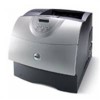Dell W5300n Dell™ Workgroup Laser Printer W5300 User's Guide - Page 39
Selecting paper, Make sure the Paper Type, Paper Texture, and Paper Weight settings are correct. See
 |
View all Dell W5300n manuals
Add to My Manuals
Save this manual to your list of manuals |
Page 39 highlights
Preprinted papers that require a registration (the precise print location on the page) greater than ±0.09 in., such as optical character recognition (OCR) forms In some cases, you can adjust registration with your software application to successfully print on these forms. Coated papers (erasable bond), synthetic papers, thermal papers Rough-edged, rough or heavily textured surface papers or curled papers Recycled papers containing more than 25% post-consumer waste that do not meet DIN 19 309 Recycled paper having a weight less than 60 g/m2 (16 lb) Multiple-part forms or documents Selecting paper Proper paper loading helps prevent jams and ensure trouble-free printing. To help avoid jams or poor print quality: Always use new, undamaged paper. Before loading paper, know the recommended print side of the paper you are using. This information is usually indicated on the paper package. Do not use paper that you have cut or trimmed yourself. Do not mix print media sizes, weights, or types in the same source; mixing results in jams. Do not use coated papers. Do not forget to change the Paper Size setting when you use a source that does not support auto size sensing. Do not remove trays while a job is printing or Busy is displayed on the operator panel. Make sure the Paper Type, Paper Texture, and Paper Weight settings are correct. (See Paper Menu for detailed information about these settings.) Make sure the paper is properly loaded in the source. Flex paper back and forth. Do not fold or crease the paper. Straighten the edges on a level surface.















